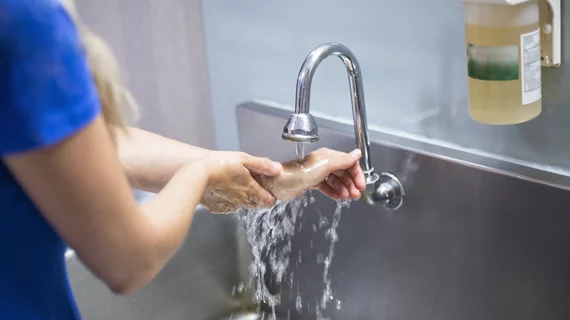How to improve workstation cleanliness among radiologists
Providing plenty of supplies and emphasizing the importance of workstation hygiene can lead to much cleaner reading rooms,, according to a new case study published in the Journal of the American College of Radiology.
The authors observed that “healthcare-associated pathogens” are often spread to patients due to unclean workplace surfaces, but radiology departments don’t always focus on cleanliness as much as they should.
“Unfortunately, many radiologists forgo hand and workstation hygiene, which may be due to existing culture and lack of education, inaccessible supplies, or the reasoning that patient contact is minimal,” wrote lead author John Campbell, MD, University of North Carolina at Chapel Hill School of Medicine, and colleagues. “However, given the combined factors of workstations contamination, frequently shared workstations, presenteeism in the physician workforce, and working in close quarters with technologists and other health care personnel, there is significant potential to improve health care outcomes by improving workstation cleaning practices.”
Looking to improve reading room cleanliness at their own tertiary care institution, Campbell et al. focused on a cohort of 34 radiology residents, nine fellows, and 26 faculty who regularly use their reading rooms. A baseline evaluation was carried out on workstations from nine different reading rooms, with the researchers focusing on the telephone receiver, telephone keypad, mouse, keyboard and microphone.
Noting that “cleaning supplies and hand-sanitizing stations were not routinely present or stocked in any of the reading rooms,” the researchers then installed disinfectant wipe dispensers, hand sanitizer dispensers and glove stations, noting that previously. The radiologists were also trained on the importance of cleanliness in the reading room, both through didactic presentation and a staff meeting.
“Radiologists also received personalized instructions in the reading room on how to properly clean their workstations and the effectiveness of their efforts over a one-week period,” the authors added. “This was done by entering the reading rooms during clinical hours and demonstrating proper workstation cleaning and showing persistence of the bioluminescent marker on workstations that were not cleaned. Lastly, we ensured that all residents and faculty knew the location of the sanitizing stations in the reading rooms as well as how to obtain refills for the station supplies.”
To test the effectiveness of their interventions, the team evaluated the workstations at various intervals. At baseline, 13% of workstations showed signs of being cleaned. Even those workstations were not completely cleaned, however. After the installation of the cleaning equipment, 17% of workstations showed evidence of being cleaned. And 37% to 58% showed signs of being cleaned during the week of education.
Finally, 40.6% of workstations showed evidence of being cleaned three moths after the team’s interventions. After six months, that number increased to 43.8%. Also, the “predicted probability of cleaning evidence” was calculated as 17.19% before the interventions and 50.37% after.
“Overall, there was a statistically significant increase in both workstations and sites sampled showing evidence of cleaning with sustained improvement up to 6 months after intervention,” the team concluded.

